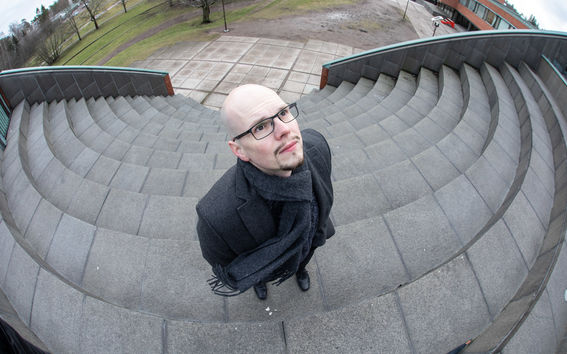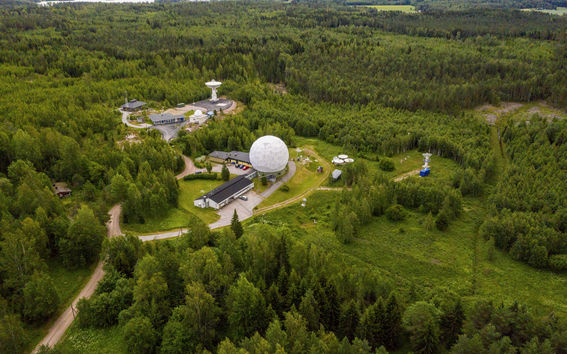Three fascinating things about space

Metsähovi Radio Observatory Director Joni Tammi started his career in astronomy while in first grade by delivering a presentation about stars to his classmates. Since then, all of his study choices steered him in a specific direction – to become a space researcher.
During his student days, Tammi learned about the use of computer simulations in space research on a course held by Professor Esko Valtaoja. Seeing galaxies collide even in the simplified simulations of the late 1990s left Tammi spellbound. He decided to specialise in theoretical astrophysics and the modelling of space phenomena.
Boundless space and the insignificance of personal problems
For Tammi, space is a part of our environment that we don’t know enough about. What about space fascinates him?
“I remember reading an encyclopaedia at my grandparents when I was a child. It showed how planetary orbits followed conic sections cut from different directions. It amazed me that such massive objects would conform with so simple mathematical forms. The beauty of maths and physics continues to intrigue me still as an adult.”
Another thing Tammi finds alluring is the vastness of space and, by contrast, the smallness of humans.
“It’s comforting to know you are so small. No matter how bad a mess your life is in, it helps to simply raise your eyes upwards and consider that, from a height of two hundred kilometres, your personal problems are no longer visible.”
A third stellar moment awaits in the future. Joni Tammi wants to find out how the forces generated by black holes turn from gravity and rotation into light and radio waves.
“We’ve seen an image of a black hole and know that particles move at near light speed and radiate powerfully in the jets generated by black holes. But we do not know what kind of processes exactly are behind this. To gain this knowledge, we require simultaneous observations of several different frequencies over the long term. This can’t be done with existing equipment.”

A revolutionary way to see the universe
Joni Tammi uses a comparison with music to illustrate how new technology would revolutionise the way we see the universe.
“Radio frequencies sort of correspond with the strings of an instrument. You can play one string loudly or quietly, fast or slow, but you can’t make music that’s much good with it. But add a few strings and you get a bass that can be used to play an enormous amount of different tunes.”
In a few years, researchers can utilise a comparable instrument for studying the cosmos. New technology makes it possible to listen to radio waves at three frequencies simultaneously, making observations much more precise and faster than they now are. Our understanding of research objects and space will increase. The number of objects being researched will also rise from the hundreds to the thousands.
The new receiver will also make us much better prepared for possible dangers, Tammi says.
“Solar flares and dangerous solar storms could be forecast weeks before they hit the Earth. Solar storms can damage satellites, electrical grids and radio-frequency data communications as well as cause massive power outages.”
In addition, a more detailed understanding of quasars will help increase the precision of satellite positioning. Quasars are extremely distant objects that radiate much more powerfully than normal galaxies.
“Once we gain information on what’s going on with quasar eruptions, researchers will be able to more precisely determine the position of the Earth relative to quasars. This will have an impact on the precision of satellite positioning as well, perhaps making it possible to enable centimetre-level accuracy.”
Metsähovi is Finland’s only astronomical observation station. In addition to research, its equipmentenables the teaching of radio astronomy and the training of researchers in this field. In order for us to remain part of the international elite, we must acquire new technology.
Please help us see better and further – make a donation towards the procurement of a radio receiver for Metsähovi: www.aalto.fi/en/donate-matsahovi

Donate towards the new Metsähovi receiver!
- Published:
- Updated:
Read more news

Maintenance break in ACRIS on 30th of September, 2024
Maintenance break in ACRIS on September from 10:00 to 16:00.
Aalto students' public art projects featured at award-winning ANTI-Festival
Last week in Kuopio, a fascinating collection of public art projects was presented by students from Aalto University's Department of Art and Media.
‘Off to a flying start’ – a new research team explores bacteria that thrive in extreme conditions
Jarno Mäkelä joined Aalto’s Department of Neuroscience and Medical Engineering as Assistant Professor of Biophysics in early September, together with research fellow Taras Redchuk, postdoctoral researchers Dan Noel, Eveliny Nery, doctoral researchers Ada Pajari and Aakeel Wagay, and research assistant Chris Hayes. They were accompanied by equipment, funding from the Academy of Finland and an ERC Starting Grant from the European Research Council.